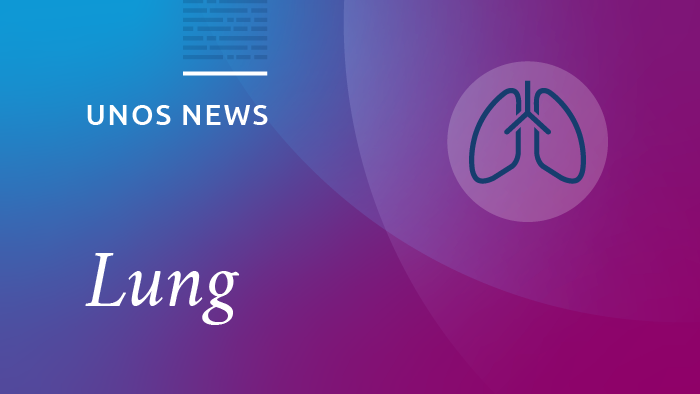Continuous distribution format provides a single, composite score for each match
Dallas – The Board of Directors of the Organ Procurement and Transplantation Network (OPTN), at its meeting Dec. 6, voted unanimously to approve a new policy for lung allocation. United Network for Organ Sharing (UNOS) serves as the OPTN under federal contract.
The policy, anticipated to take effect early in 2023, combines all matching factors into a single composite score each candidate will receive when matched with a specific lung offer from a donor. This combined score will replace a series of matching categories currently used to assess patients’ transplant priority.
“This is an innovative reworking of transplant allocation policy,” said Matthew Cooper, M.D., president of the board. “It is a testament to the success of our policy-making process that thousands of clinicians, patients and members of the public have contributed to this new design and agreed overwhelmingly to the resulting proposal.”
The new policy is based on a concept known as continuous distribution, which the OPTN board approved in 2018 as a framework for future allocation policy development. When the new policy takes effect, each lung candidate will receive a composite allocation score for each organ offer. This score combines weighted priority for a number of factors that show the candidate’s need for a transplant and how well they match the organ donor.
Simulation modeling of the proposal performed by the Scientific Registry of Transplant Recipients (SRTR) suggests that the new policy is likely to improve key measures of the lung transplant system, including:
- A reduction in patient deaths on the waiting list by more than one-third
- An increase in transplant rates for candidates at the highest medical urgency
- An improvement in two-year post-transplant survival
- Decreased variability in transplant rates between different areas of the country
Weighted efficiency score to replace fixed allocation boundaries
As one part of the composite allocation score, the new policy will eliminate fixed geographic boundaries currently used to separate groups of candidates based on distance between the donor hospital and their transplant hospital. Such distance will be considered as part of the overall score as a measure of organ placement efficiency.
Under the new policy, distance will receive only a weighted value that gives higher priority to candidates at hospitals closer to the donor location. That value will be balanced alongside other matching factors that receive other weighted scores.
Policy reflects extensive public involvement
The OPTN Thoracic Organ Transplantation Committee began work on the policy in 2019, which continued under the OPTN Lung Transplantation Committee established in 2020. The committee discussed the factors that would be included under the new policy, and it published a concept paper in 2019. The specific prioritization and weighting of the factors was further shaped through input from donation and transplant professionals, transplant candidates and recipients and their family members, donor family members, and other interested members of the public.
A key part of the policy’s development came from participation in a process known as the analytical hierarchy process (AHP). This is a structured prioritization exercise that allows any interested person to rank-order various aspects of the matching process against one another. The AHP results provided insights the committee used to group the factors of the matching score together and decide how much priority each would have within the overall score.
The Lung Transplantation Committee circulated a policy proposal for public comment from August through September 2021. The proposal was broadly supported across many regions of the country and by people representing a variety of clinical and personal perspectives.

